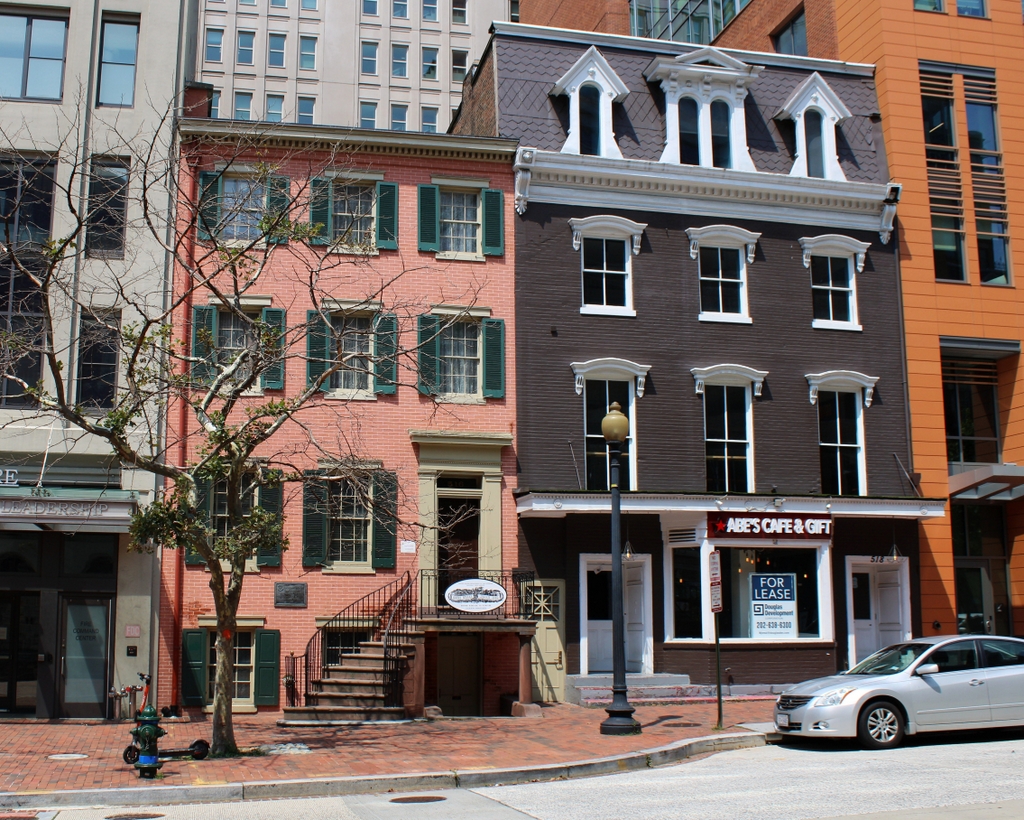The Petersen House at 516 10th Street NW in Washington, DC, around 1918-1920. Image courtesy of the Library of Congress, National Photo Company Collection.
The scene in 2021:
These two photos show the Petersen House, a rowhouse that is famous for having been the place where Abraham Lincoln died on the morning of April 15, 1865. It is located on the west side of 10th Street NW, on the block between E Street and F Street, and it was built in 1849. The original owners of the house were William and Anna Petersen, German immigrants who had arrived in the United States in 1841. William was a tailor, but the family also earned money by taking in boarders, including nine who were living here at the time of Lincoln’s assassination.
On the night of April 14, 1865, Abraham Lincoln was attending a performance of Our American Cousin at Ford’s Theatre, which is located across the street from here. During the play, at around 10:15, John Wilkes Booth entered the presidential box and shot Lincoln in the head, before jumping down to the stage and making his escape. In the meantime, several doctors who were in the audience rushed to Lincoln’s box to treat him, and they determined that the wound was fatal.
Rather than trying to move Lincoln all the way to the White House, the doctors decided to find a nearby house. Lincoln was carried outside, and around this same time one of the boarders at the Petersen House, Henry S. Safford, heard a commotion outside and went out to investigate. Seeing the men carrying the president, he waved them into the house, and directed them toward a bedroom in the rear of the first floor.
A number of physicians attended to Lincoln throughout the night, but there was little that they could do beyond removing blood clots. Mary Todd Lincoln was here for part of the night with her husband, as was their son, Robert Todd Lincoln. Other important visitors included Secretary of War Edwin Stanton, Secretary of the Navy Gideon Welles, Vice President Andrew Johnson, and Senator Charles Sumner. Many of them were present when Lincoln died at 7:22 in the morning, including Stanton, who famously said either “now he belongs to the ages” or “now he belongs to the angels” after Lincoln’s death.
For the Petersen family, having the president die in their house certainly brought them a great deal of attention, but it did little to help their financial situation. Hundreds of visitors streamed into the house every day, with many of them making off with whatever souvenirs they could take, including cutting off pieces of the carpet, the wallpaper, and even the bloody sheets. All of the boarders ended up moving elsewhere, because of the lack of privacy from the many curious visitors.
William Petersen eventually died of an overdose of laudanum in 1871, and his wife Anna died four months later. Their heirs owned the house for several more years, before selling the property to Louis and Anna Schade in 1878. They, in turn, sold the house to the federal government in 1896, which preserved it as a museum, making the house a very early example of historic preservation in the United States.
The first photo was taken around 1918-1920, showing the exterior of the house along with the adjacent buildings. As indicated by the sign on the front stairs, the house featured the “Oldroyd Lincoln Memorial Collection of over 3,000 articles,” and it was open to the public “at all hours,” for an admission price of 25 cents. This collection was owned by Osborn H. Oldroyd, who had lived in the house since the late 1890s. He served as the caretaker of the house, and in return he paid no rent, and he was allowed to charge a small admission fee for visitors to see his extensive collection. Oldroyd eventually sold this collection to the federal government in 1926, four years before his death. Then, in 1932, the collection was moved across the street to Ford’s Theatre.
Today, more than a century after the first photo was taken, the surrounding area has seen considerable changes. However, both the Petersen House and the neighboring building to the right are still standing from the first photo. The Petersen House is still owned by the federal government, and it is administered by the National Park Service as part of the Ford’s Theatre National Historic Site, which includes both the house and the restored theater across the street.


